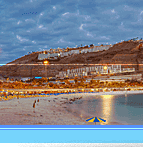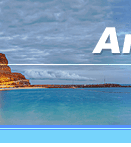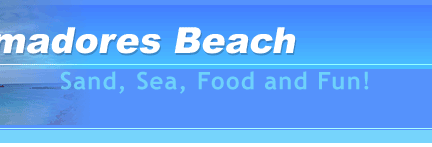Home to Amadores Beach
History of Amadores Beach - How a Man-Made Paradise Was Created
Yes, Amadores Beach is completely man-made. This stunning Gran Canaria beach was created from scratch in 2002, transforming a rocky coastline into one of the Canary Islands' most beautiful and family-friendly destinations.
🏖️ Quick Facts About Amadores Beach Construction
- Built: 2002 (over 20 years ago)
- Sand Source: Crushed coral imported from the Caribbean
- Beach Length: 800 meters of artificial coastline
- Construction Method: Protected bay created with massive breakwaters
Why Was Amadores Beach Built?
Before 2002, the Amadores area was simply a rugged section of Gran Canaria's volcanic coastline with no natural beach. The rocky shores and rough Atlantic waves made it unsuitable for swimming or tourism development.
Recognizing the potential for creating a protected beach destination between Puerto Rico and Puerto de Mogán, developers embarked on an ambitious project to build an artificial bay that would provide:
- Safe Swimming: Calm, protected waters for families
- Tourist Infrastructure: Space for hotels, restaurants, and facilities
- Economic Development: New employment and tourism revenue for the region
- Environmental Protection: Designed to minimize coastal erosion
How Amadores Beach Was Constructed
Step 1: Building the Breakwaters
Massive concrete breakwaters were constructed at both the north and south ends of the bay. These artificial barriers:
- Protect the beach from Atlantic swells and storms
- Create calm, lagoon-like swimming conditions
- Allow sediment and sand to accumulate naturally
- Provide foundations for marine life development
Step 2: Importing Caribbean Coral Sand
The distinctive golden-white sand at Amadores comes from crushed coral imported directly from the Caribbean. This choice was deliberate:
🌴 Why Caribbean Coral Sand?
- Temperature Control: Coral sand stays cooler than volcanic sand, comfortable for bare feet even on hot days
- Color & Texture: Creates the tropical paradise appearance visitors expect
- Durability: More resistant to erosion than Saharan sand alternatives
- Safety: Soft texture perfect for children's play and bare feet
Step 3: Infrastructure Development
The artificial beach required extensive infrastructure:
- Covered promenade running the full length of the beach
- Restaurant and retail spaces built into the coastal design
- Parking areas carved into the hillside
- Utilities and sewage systems for resort development
- Landscaping with palm trees and tropical plants
Engineering Challenges Overcome
Creating Amadores Beach required solving significant engineering challenges:
The "Drop-Off" Design
Visitors often notice the sudden depth change where the artificial sand ends and the natural seabed begins. This engineering feature:
- Maintains the imported sand within the protected bay
- Prevents sand loss to deeper waters
- Creates distinct shallow and deep water zones
- Allows for different swimming experiences
Environmental Integration
Despite being completely artificial, Amadores was designed to:
- Blend naturally with the surrounding coastline
- Support marine ecosystem development
- Minimize visual impact on the landscape
- Provide sustainable tourism infrastructure
Comparison with Other Artificial Beaches
Amadores is one of several man-made beaches in the Canary Islands:
- Las Teresitas (Tenerife): Uses Saharan sand, 1.3km long
- Puerto Rico (Gran Canaria): Artificial harbor with imported sand
- Playa del Inglés: Enhanced natural beach with imported sand
- Anfi del Mar (Gran Canaria): White Caribbean sand like Amadores
Environmental Impact and Marine Life
Twenty years after construction, Amadores has developed into a thriving ecosystem:
🐠 Marine Life Development
The artificial reefs created by the breakwaters now support diverse marine life including:
- Tropical fish species
- Sea wrasse and damselfish
- Angel sharks and stingrays
- Barracuda nursery areas
- Cuttlefish and squid
Blue Flag Achievement
Since 2004, Amadores Beach has maintained Blue Flag status, recognizing its achievement in:
- Water quality standards
- Environmental management
- Safety services
- Beach facilities
Economic and Social Impact
The creation of Amadores Beach transformed the local area:
- Employment: Hundreds of jobs in hotels, restaurants, and services
- Tourism Revenue: Major contribution to Gran Canaria's economy
- Property Development: Luxury hotels and residential complexes
- Regional Connectivity: Improved transport links between resorts
Modern Maintenance and Sustainability
Maintaining an artificial beach requires ongoing efforts:
- Sand Replenishment: Periodic addition of new coral sand
- Breakwater Maintenance: Structural integrity monitoring
- Environmental Monitoring: Water quality and marine life protection
- Facility Upgrades: Continuous improvement of visitor amenities
Today, Amadores Beach stands as a testament to thoughtful coastal engineering, proving that artificial beaches can be both environmentally responsible and incredibly beautiful. The combination of Caribbean coral sand, protective breakwaters, and careful landscape design has created a beach that many visitors assume is completely natural—the ultimate compliment to its creators' vision and skill. For current information about weather conditions and seasonal planning, plus nearby shopping and Puerto Rico attractions, explore our comprehensive guides.
|









